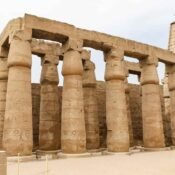
Habu Temple in Luxor
Medinat Habu Temple is regarded by many visitors as one of the most impressive sights they see in Luxor, despite not being one of the more popular attractions on the West Bank of Luxor. Especially when compared to the Ramesseum where it stands, this temple complex has been admirably preserved.
Although Ramses II, a more well-known pharaoh, built the Ramesseum, Ramses III’s Medinat Habu is a considerably more spectacular structure, with its pylon, many walls, and obvious original paint sculpted exterior.
Who did build Habu Temple?
The final legendary pharaoh of Egypt was Ramesses III, who ruled from 1184 to 1153 BC. Egypt experienced a protracted period of decline after his administration because, following the New Kingdom, it was governed by foreign nations throughout the majority of its history.
The burden of the prospect of invasion from numerous frontiers proved to be too strong after Ramesses II had fully enlarged the empire. The last pharaoh to be attributed with significant building initiatives—this temple complex being the most significant of them all—was Ramesses III.
Ramesses III (reigned 1184-1153 BC) was Egypt’s final great pharaoh. After his reign, Egypt experienced a long period of decline, as it was governed by foreign countries for the majority of its history following the New Kingdom. The burden of the threat of invasion from numerous boundaries was too severe once Ramesses II enlarged the empire to its utmost extent.
Ramesses III was the final pharaoh to be attributed with large architectural undertakings, the most noteworthy of which was this temple complex
Recent Posts
Luxor day tour: Most Illuminated Temples
Discover Luxury Nile Cruises
Designing the Perfect Itinerary for Your Nile Cruise




